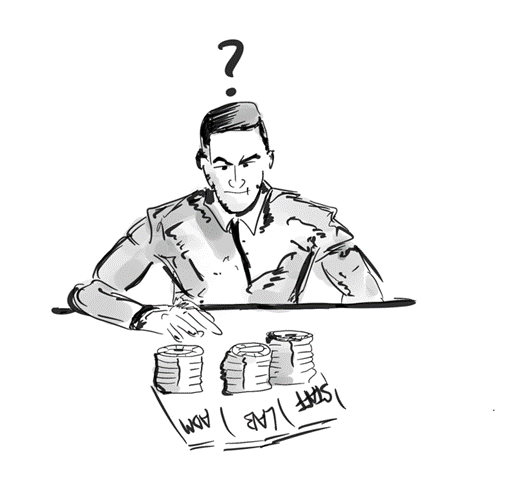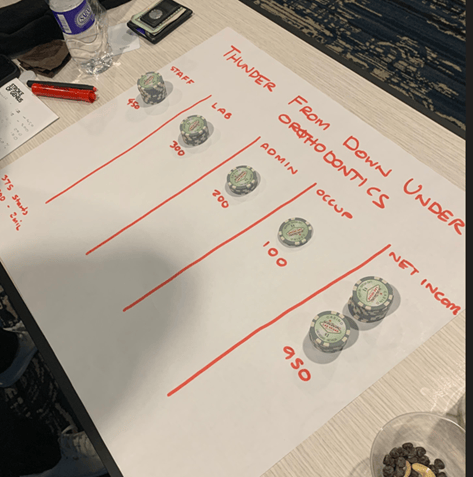- The Moment
- Posts
- Poker Chips, Practices, and P&Ls
Poker Chips, Practices, and P&Ls

“Someone wise told me that every 2nd thought an orthodontist has is about their practice.
Unless you can speak to helping their practice...nothing will register. And to prove this point, let’s see what you know…”
______________________________
I’ve led sales trainings for three different companies. I love it, have a passion for it, and enjoy teaching new and tenured professionals outside of my duties in this role.
And nothing teaches better than doing.
So last month, I flew to Philadelphia to have our sales team play a game: How would they manage a practice.. if they held the chips?
Here’s how it worked out, and the 5 lessons gathered:
____________________________
Lesson 1: “So…staffing is expensive”
I divided everyone up in teams of 2 or 3. Each team was a ‘practice’, and made up a practice name – including “Thunder from Down Under Orthodontics” from our guy in Australia.
I gave each team 40 poker chips. Each poker chip was worth $50,000:
“Congrats - Each of your practices did $2m in collections. That’s ~375 starts. And you all had a collection fee of $5,333. Even better, all starts paid in full! So you each earned 40 poker chips, worth $50k a piece. Great job on a great year!….But unfortunately, you don’t get to keep all the chips to yourself... So knowing what you ‘think’ you know, stack your 40 chips into 4 expense piles, with your practice keeping whatever remains as your take home & net profits.”
Each team had 5 minutes to divvy 40 poker chips into 4 piles:
Staff Salary
Lab and Appliance Fees
Business Admin + Marketing Expenses
Occupancy Expenses
With leftovers going to :
EBDITA (Earnings before Depreciation, Interest, Taxes and Amortization)
You know, the basics of an orthodontic practice P&L – using whatever they could recall about expenses, profit margins, and industry medians. (And a testament to how many listened to Bentson over the years.) What’s interesting is that everyone got one thing correct:
Staffing was the highest stacked pile in the expense categories.
For $2m in collections, all had a half a million or more (10 poker chips) on their team.
Which led to the first lesson: The team is the most important resource -and largest expense- in a practice.

Lesson 2: “Never judge a practice by starts alone.”
Each practice did 375 starts and collected $2m, but the actual profitability of practices became vastly different amongst the teams.
“Now you all had the same production, but look at net income piles. Any practice millionaires in the room? Raise your hand... None. Ok, how about those with net income over $900k?
1 practice had an EBIDTA of $900k (18 poker chips) on $2m in collections. The next closest: $650k. (13 poker chips). The difference? Expenses.
“So looking at these EBIDTA (net income) pile differences - This team was $250k more profitable with the same amount of starts. Why is that? And better, what are their expenses? Because this is a valuable lesson: It’s not what you make, it’s what you keep that determines practice profitability. This is why a 275 solo-doctor practice can be just as profitable as a 450 2-doctor practice.
The lesson: Never assume higher starts is more profits.
Lesson 3: Why you’ll rarely see a practice go out of business...
After laughing and learning about the flaws in some of the P&L’s (one team left little for occupancy), each team moved their 40 poker chips to the orthodontic practice medians per Chris Bentson.
10 chips on staff ($500k)
5 chips on lab ($250k)
5 chips on admin, and ($250k)
4 chips on occupancy. ($200k)
Leaving EDBITA at 16 chips, or $800k (the industry median of a $2m practice)
Here was another lesson and eye-opener for some: The profit margins in this industry are fantastic.
With 40% net profitability, it only takes ~182 patients to achieve profitability given fixed costs on a 375-start practice.
Every start post-182 is a variable cost at 70-86% VCM!
Lesson 4: How much does it take to grow profit by $100k?
Because the industry margins are 60/40 expense to profit, it takes roughly 5-6 poker chips (or ~$250-$300k in revenue) to increase a practice net income by $100k, or 2 poker chips.
If a practice wants to “grow EBDITA by $100k”, it will either need to:
Bring on 5-6 chips of top-line revenue
or
Take 2 chips from one of the expense piles
Lesson: A practice can only grow profitability by 1) getting more patients, 2) have each patient do multiple treatments and/or purchase offerings 3) or raise prices…or cut resources.
Lesson 5: A choice..
If you increase production, you increase expenses. You can’t avoid it over the long-run. And for years, its been the same algebra formula for growth: +patients + staff + resources (chairs, clinic time, doctor time) = practice growth. But what’s interesting is how you can choose your path to growth via expenses. A practice has a choice: either they’ll pay for it in more occupancy, more staffing, and more clinic time… OR they’ll pay for it the form of an increase cost for efficiency in return for less time, team, and smaller occupancy.
The profitability should be the same over the long-term.
Making this not a right or wrong choice for growth. Just a choice. And it isn’t mutually exclusive.
But being able to speak to the strategy of growth is the point of the final lesson.
Some may find aligners, or digital braces, or remote monitoring, or virtual assistants is their path.
Some may find that managing people, adding more associates, hiring and training is their path.
It’s how we can help advise. We live in a world where the growth equation has changed. Maybe practices don’t need to continue to hire or replace. Maybe practices don’t need another chair. Maybe practices don’t need to add another clinic day. There are new choices on how to stack the chips.
…..And that’s how I ended the meeting.
With quote from an orthodontist who chose a digital path to growth:
“We ran 6 chairs and 15 doctor days a month before. Our practice is bigger now than ever before. We now run 4 chairs and 11 doctor days. Natural staff attrition without rehiring - and with appt reduction from digital efficiencies - allowed me to drop 4 clinic days a month.
It can totally be done.
But it’s a conscious effort to see practice growth and expenses differently...”